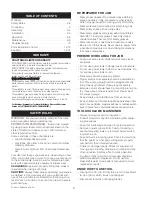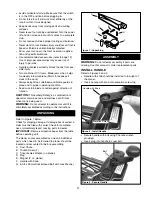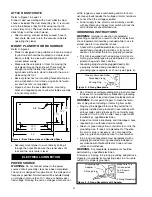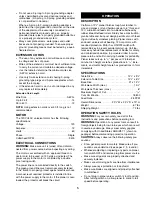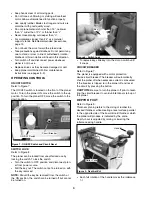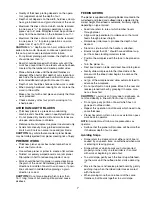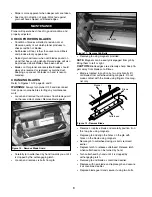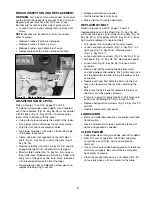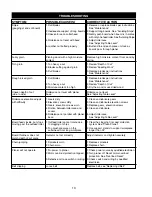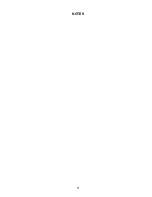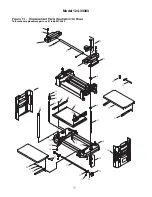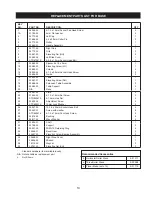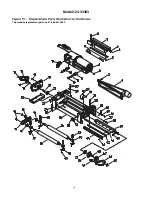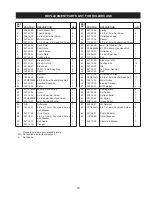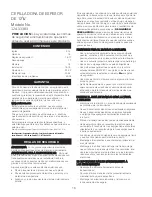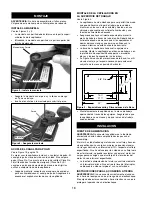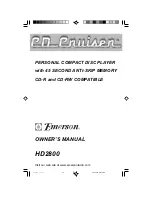
ATTACH DUST CHUTE
Refer to Figure 15, page 14.
Planer is best used along with a dust collector. Dust
chute is included. The dust chute (Key No. 1) is mount-
ed to the rollercase (Key No. 26) using two thumb
screws (Key No. 2). The dust chute can be mounted to
direct chips to either side of planer.
•
After mounting, connect wet/dry vacuum hose to
dust chute. Be sure to turn the vacuum on before
operating the planer.
MOUNT PLANER TO WORK SURFACE
Refer to Figure 4.
•
Planer is designed to be portable so it can be moved
to job site, but should be mounted to a stable, level
bench or table in a place with ample lighting and
correct power supply.
•
Make sure there is plenty of room for moving the
workpiece through the entire cut. There must be
enough room that neither the operators or the
bystanders will have to stand in line with the wood
while using the tool.
•
Base of planer has four mounting holes.Mount plan-
er to workbench or tool stand using bolts, flat wash-
ers and hex nuts (not supplied).
•
Figure 4 shows the base dimensions, mounting
holes and required space to allow for table assembly
in horizontal position.
•
Securely mount planer to work table by bolting it
through the holes. Make sure the planer does not
rock and the work table is level.
(/(&75,&$/&211(&7,21
POWER SOURCE
WARNING:
Do not connect planer to the power
source until all assembly steps have been completed.
The motor is designed for operation on the voltage and
frequency specified. Normal loads will be handled safely
on voltages not more than 10% above or below speci-
fied voltage. Running the unit on voltages which are not
within range may cause overheating and motor burn-
out. Heavy loads require that voltage at motor terminals
be no less than the voltage specified.
•
Power supply to the motor is controlled by a switch
with key. Removing the key from switch will lock the
unit and prevent unauthorized use.
GROUNDING INSTRUCTIONS
WARNING:
Improper connection of equipment
grounding conductor can result in the risk of electrical
shock. Equipment should be grounded while in use to
protect operator from electrical shock.
•
Check with a qualified electrician if you do not
understand grounding instructions or if you are in
doubt as to whether the tool is properly grounded.
•
This tool is equipped with an approved cord and a
3-prong grounding type plug (see Figure 5) for your
protection against shock hazards.
•
Grounding plug should be plugged directly into
a properly installed and grounded 3- prong
grounding-type receptacle, as shown (see Figure 5).
•
Do not remove or alter grounding prong in any manner.
In the event of a malfunction or breakdown, grounding
provides a path of least resistance for electrical shock.
WARNING:
Do not permit fingers to touch the termi-
nals of plug when installing or removing from outlet.
•
Plug must be plugged into matching outlet that is
properly installed and grounded in accordance with
all local codes and ordinances. Do not modify plug
provided. If it will not fit in outlet, have proper outlet
installed by a qualified electrician.
•
Inspect tool cords periodically, and if damaged, have
repaired by an authorized service facility.
•
Green (or green and yellow) conductor in cord is the
grounding wire. If repair or replacement of the elec-
tric cord or plug is necessary, do not connect the
green (or green and yellow) wire to a live terminal.
•
A 2-prong wall receptacle must be replaced with a
properly grounded 3-prong receptacle installed in
accordance with National Electric Code and local
codes and ordinances.
WARNING:
Any receptacle replacement should be
performed by a qualified electrician.
A temporary 3-prong to 2-prong grounding adapter (see
Figure 6) is available for connecting plugs to a two pole
outlet if it is properly grounded.
4
Figure 6 - 2-Prong Receptacle with Adapter
Make Sure This
Is Connected
To A Known
Ground
2-Prong Receptacle
Grounding Lug
Adapter
3-Prong Plug
Figure 5 - 3-Prong Receptacle
Grounding Prong
3-Prong Plug
Properly Grounded Outlet
3/8
″
Dia.
11
3
/
8
″
14
5
/
16
″
21
1
/
8
″
24
″
20
″
12
5
/
8
″
Figure 4 - Base Dimensions and Required Space
Summary of Contents for 124.33383
Page 11: ...11 NOTES ...
Page 14: ... PEFM 5P QVSDIBTF SFQMBDFNFOU QBSUT DBMM ...
Page 27: ...27 NOTAS ...


